List of World Heritage Sites in the United Kingdom

The United Nations Educational, Scientific and Cultural Organization (UNESCO) World Heritage Sites are places of importance to cultural or natural heritage as described in the UNESCO World Heritage Convention, established in 1972.[1]
There are 35 UNESCO World Heritage Sites in the United Kingdom and the British Overseas Territories.[2] The UNESCO list contains one designated site in both England and Scotland (the Frontiers of the Roman Empire) plus eighteen exclusively in England, six in Scotland, four in Wales, two in Northern Ireland, and one in each of the overseas territories of Bermuda, Gibraltar, the Pitcairn Islands, and Saint Helena. There is an additional site partly in the UK territory of Akrotiri and Dhekelia, but is regarded to be part of Cyprus's list. The first sites in the UK to be inscribed on the World Heritage List were Giant's Causeway and Causeway Coast; Durham Castle and Cathedral; Ironbridge Gorge; Studley Royal Park including the Ruins of Fountains Abbey; Stonehenge, Avebury and Associated Sites; and the Castles and Town Walls of King Edward in Gwynedd in 1986. The latest sites to be inscribed were The Slate Landscape of Northwest Wales and Bath Spa (as a component of the Great Spas of Europe) in July 2021.[3][4]
The constitution of the United Nations Educational, Scientific and Cultural Organization (commonly referred to as UNESCO) was ratified in 1946 by 26 countries, including the UK. Its purpose was to provide for the "conservation and protection of the world’s inheritance of books, works of art and monuments of history and science".[5] The UK contributes £130,000 annually to the World Heritage Fund which finances the preservation of sites in developing countries.[6] Some designated properties contain multiple sites that share a common geographical location or cultural heritage.
The United Kingdom National Commission for UNESCO advises the British government, which is responsible for maintaining its World Heritage Sites, on policies regarding UNESCO.[7] The UK National Commission for UNESCO conducted research in 2014–15 on the Wider Value of UNESCO to the UK, and found that the UK's World Heritage Sites generated an estimated £85 million from April 2014 to March 2015 through their association with the global network.[8]
World Heritage Site selection criteria i–vi are culturally related, and selection criteria vii–x are the natural criteria.[9] Twenty-three properties are designated as "cultural", four as "natural", and one as "mixed".[note 1][2] The breakdown of sites by type was similar to the overall proportions; of the 1,121 sites on the World Heritage List, 77.5% are cultural, 19% are natural, and 3.5% are mixed.[10] St Kilda is the only mixed World Heritage Site in the UK. Originally preserved for its natural habitats alone,[11] the site was expanded in 2005 to include the crofting community that once inhabited the archipelago; the site became one of only 25 mixed sites worldwide.[12] The natural sites are the Dorset and East Devon Coast; Giant's Causeway and Causeway Coast; Gough and Inaccessible Islands; and Henderson Island. The rest are cultural.[2]
In 2012, the World Heritage Committee added Liverpool – Maritime Mercantile City to the List of World Heritage in Danger, citing threats to the site's integrity from planned urban development projects.[13] The site was stripped of World Heritage status in 2021.[14]
Location of sites
[edit]The UNESCO list contains one designated site in both England and Scotland (the Frontiers of the Roman Empire, which is also in Germany)[15] with another sixteen in England, five in Scotland, four in Wales, one in Northern Ireland, and one in each of the overseas territories of Bermuda, Gibraltar, the Pitcairn Islands, and Tristan da Cunha. The maps below show all current World Heritage Sites.
The World Heritage Sites of the United Kingdom: cultural sites marked red, natural sites marked green, mixed site (St Kilda) marked blue. Names are abridged to fit on the map. Greater London is home to the cultural sites of Maritime Greenwich, Royal Botanical Gardens, Kew, Tower of London, and Palace of Westminster and Westminster Abbey including Saint Margaret's Church. |
The World Heritage Sites of London: cultural sites marked red, natural sites marked green, mixed sites marked blue. Names are abridged to fit on the map. Greater London is home to the cultural sites of Maritime Greenwich, Royal Botanical Gardens, Kew, Tower of London, and Palace of Westminster and Westminster Abbey including Saint Margaret's Church. |
 |
List of sites
[edit]The table lists information about each World Heritage Site:
- Name: as listed by the World Heritage Committee[10]
- Location: in one of the UK's constituent countries and overseas territories, with co-ordinates provided by UNESCO
- Period: time period of significance, typically of construction
- UNESCO data: the site's reference number, the year the site was inscribed on the World Heritage List, and the criteria it was listed under
- Description: brief description of the site
| Name | Image | Location | Country / territory | Coords | Date | UNESCO data | Description |
|---|---|---|---|---|---|---|---|
| Blaenavon Industrial Landscape | 
|
Blaenavon, [16] |
Wales | 51°47′N 3°05′W / 51.78°N 3.08°W | 19th century[16] | 984; 2000; iii, iv[16] |
In the 19th century, Wales was the world's foremost producer of iron and coal. Blaenavon is an example of the landscape created by the industrial processes associated with the production of these materials. The site includes quarries, public buildings, workers' housing, and a railway.[16] |
| Blenheim Palace | 
|
Woodstock, Oxfordshire, [17] |
England | 51°50′28″N 1°21′40″W / 51.841°N 1.361°W | 1705–1722[17] | 425; 1987; ii, iv[17] |
Blenheim Palace, the residence of John Churchill, 1st Duke of Marlborough, was designed by architects John Vanbrugh and Nicholas Hawksmoor. The associated park was landscaped by Capability Brown. The palace celebrated victory over the French and is significant for establishing English Romantic Architecture as a separate entity from French Classical Architecture.[17] |
| Canterbury Cathedral, St Augustine's Abbey, and St Martin's Church | 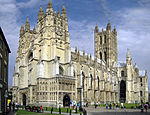
|
Canterbury, Kent, [18] |
England | 51°17′N 1°05′E / 51.28°N 1.08°E | 11th century[18] | 496; 1988; i, ii, vi[18] |
St Martin's Church is the oldest church in England. The church and St Augustine's Abbey were founded during the early stages of the introduction of Christianity to the Anglo-Saxons. The cathedral exhibits Romanesque and Gothic architecture, and is the seat of the Church of England.[18][19][20] |
| Castles and Town Walls of King Edward in Gwynedd | 
|
Conwy, Isle of Anglesey and Gwynedd, [21] |
Wales | 53°08′20″N 4°16′34″W / 53.139°N 4.276°W | 13th–14th centuries[21] | 374; 1986; i, iii, iv[21] |
During the reign of Edward I of England (1272–1307), a series of castles were constructed in Wales with the purpose of subduing the population and establishing English colonies in Wales. The World Heritage Site covers many castles including Beaumaris, Caernarfon, Conwy, and Harlech. The castles of Edward I are considered the pinnacle of military architecture by military historians.[21][22] |
| City of Bath | 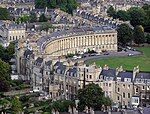
|
Bath, Somerset, [23] |
England | 51°22′48″N 2°21′36″W / 51.380°N 2.360°W | 1st–19th centuries[23] | 428; 1987; i, ii, iv[23] |
Founded by the Romans as a spa, an important centre of the wool industry in the medieval period, and a spa town in the 18th century, Bath has a varied history. The city is preserved for its Roman remains and Palladian architecture.[23] |
| Cornwall and West Devon Mining Landscape | 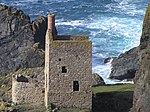
|
Cornwall and Devon, [24] |
England | 50°08′N 5°23′W / 50.13°N 5.38°W | 18th and 19th centuries[24] | 1215; 2006; ii, iii, iv[24] |
Tin and copper mining in Devon and Cornwall boomed in the 18th and 19th centuries, and at its peak the area produced two-thirds of the world's copper. The techniques and technology involved in deep mining developed in Devon and Cornwall were used around the world.[24] |
| Derwent Valley Mills | 
|
Derwent Valley, Derbyshire, [25] |
England | 53°01′12″N 1°29′56″W / 53.020°N 1.499°W | 18th and 19th centuries[25] | 1030; 2001; ii, iv[25] |
The Derwent Valley Mills was the birthplace of the factory system; the innovations in the valley, including the development of workers' housing – such as at Cromford – and machines such as the water frame, were important in the Industrial Revolution. The Derwent Valley Mills influenced North America and Europe.[26] |
| Dorset and East Devon Coast | 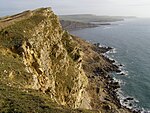
|
Dorset and Devon, [27] |
England | 50°42′N 2°59′W / 50.70°N 2.98°W | 1029; 2001; viii[27] |
The cliffs that make up the Dorset and Devon coast are an important site for fossils and provide a continuous record of life on land and in the sea in the area since 185 million years ago.[27] | |
| Durham Castle and Cathedral | 
|
Durham, County Durham, [28] |
England | 54°46′26″N 1°34′30″W / 54.774°N 1.575°W | 11th and 12th centuries[28] | 370; 1986; ii, iv, vi[28] |
Durham Cathedral is the "largest and finest" example of Norman architecture in England and vaulting of the cathedral was part of the advent of Gothic architecture. The cathedral houses relics of St Cuthbert and Bede. The Norman castle was the residence of the Durham prince-bishops.[28] |
| The English Lake District | 
|
Cumbria, [29] |
England | 54°28′26″N 3°4′56″W / 54.47389°N 3.08222°W | 422; 2017; ii, v, vi[29] |
Famous for its scenic landscape of mountains, lakes, houses, gardens and parks, the Lake District was celebrated through picturesque and romantic visual arts and literature from the 18th century on.[29] | |
| The Flow Country | 
|
Caithness and Sutherland, 58°20′53″N 3°59′0″W / 58.34806°N 3.98333°W[30] |
Scotland | 1722; 2024; ix[30] |
Expansive blanket bog landscape | ||
| Forth Bridge | 
|
Edinburgh, Inchgarvie and Fife, [31] |
Scotland | 56°00′02″N 3°23′19″W / 56.000421°N 3.388726°W | 1890 | 1485; 2015; i, iv[31] |
The Forth Bridge is a cantilever railway bridge over the Firth of Forth in the east of Scotland, 9 miles (14 kilometres) west of Edinburgh City Centre. It is considered an iconic structure and a symbol of Scotland. It was designed by the English engineers Sir John Fowler and Sir Benjamin Baker and built by Sir William Arrol of Glasgow who also built Tower Bridge in London. |
| Frontiers of the Roman Empire | 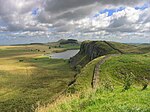
|
Northern [32] |
England, Scotland | 54°59′N 2°36′W / 54.99°N 2.60°W | 2nd century[32] | 430; 1987 (modified in 2005 and 2008); ii, iii, iv[32] |
Hadrian's Wall was built in 122 AD and the Antonine Wall was constructed in 142 AD to defend the Roman Empire from "barbarians".[32] The World Heritage Site was previously listed as Hadrian's Wall alone, but was later expanded to include the Antonine Wall in Scotland and the barriers, walls and forts in modern Germany.[33] |
| Giant's Causeway and Causeway Coast | 
|
County Antrim, Northern Ireland [34] |
Northern Ireland | 55°14′24″N 6°30′40″W / 55.240°N 6.511°W | 60–50 million years ago[34] | 369; 1986; vii, viii[34] |
The causeway is made up of 40,000 basalt columns projecting out of the sea. It was created by volcanic activity in the Tertiary period. It has been an inspiration for legends and has been the site of development in earth studies over the past 300 years.[34] |
| Gorham's Cave Complex | 
|
East face of the Rock of Gibraltar, [35] |
Gibraltar | 36°07′13″N 5°20′31″W / 36.120397°N 5.342075°W | 33-23 thousand years ago[36] | 1500; 2016; iii[35] |
Comprising four natural sea caves, the complex is the last known site of Neanderthal inhabitation some 28,000 years ago. Evidences of occupation by modern humans are also present at the site.[35] |
| Gough and Inaccessible Islands | 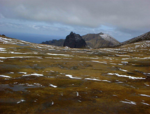
|
[37] |
Saint Helena, Ascension and Tristan da Cunha | 40°19′05″S 9°56′07″W / 40.3181°S 9.9353°W | 740; 1995 (modified in 2004); vii, x[37] |
Together, the Gough and Inaccessible Islands preserve an ecosystem almost untouched by mankind, with many endemic species of plants and animals.[37] | |
| Gracehill | County Antrim, Northern Ireland (Transnational property) | Northern Ireland | 54°51′00″N 6°20′00″W / 54.85°N 6.333333°W | 1468; 2024 | |||
| Great Spas of Europe | 
|
Bath, Somerset, (Transnational property) |
England | 1st–20th centuries[38] | 1613; 2021; ii, iii[38] |
The city of Bath is one of the Great Spa Towns of Europe, which is World Heritage Site which contains multiple towns that are renowned for their baths. | |
| Heart of Neolithic Orkney | 
|
Orkney, [39] |
Scotland | 58°59′46″N 3°11′17″W / 58.996°N 3.188°W | 3rd millennium BC[39] | 514; 1999; i, ii, iii, iv[39] |
A collection of Neolithic sites with purposes ranging from occupation to ceremony. It includes the settlement of Skara Brae, the chambered tomb of Maes Howe and the stone circles of Stenness and Brodgar.[39] |
| Henderson Island | 
|
Henderson Island, [40] |
Pitcairn Islands | 24°21′S 128°19′W / 24.35°S 128.31°W | n/a | 487; 1988; vii, x[40] |
The island is an atoll in the south of the Pacific Ocean, the ecology of which has been almost untouched by man and its isolation illustrates the dynamics of evolution. There are ten plant and four animal species endemic to the island.[40] |
| Historic Town of St George and Related Fortifications, Bermuda | 
|
St George, [41] |
Bermuda | 32°22′46″N 64°40′40″W / 32.379444°N 64.677778°W | 17th–20th centuries[41] | 983; 2000; iv[41] |
Founded in 1612, St George's is the oldest English town in the New World and an example of planned urban settlements established in the New World in the 17th century by colonial powers. The fortifications illustrate defensive techniques developed through the 17th to 20th centuries.[41] |
| Ironbridge Gorge | 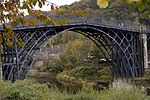
|
Ironbridge, Shropshire, [42] |
England | 52°37′34″N 2°29′10″W / 52.626°N 2.486°W | 18th century[42] | 371; 1986; i, ii, iv, vi[42] |
Ironbridge Gorge contains mines, factories, workers' housing, and the transport infrastructure that was created in the gorge during the Industrial Revolution. The development of coke production in the area helped start the Industrial Revolution. The Iron Bridge was the world's first bridge built from iron and was architecturally and technologically influential.[42] |
| Jodrell Bank Observatory | 
|
Cheshire, [43] |
England | 53°14.5′N 2°18.7′W / 53.2417°N 2.3117°W | 1945[43] | 1594; 2019; i, ii, iv, vi[43] |
Located in a rural area of northwest England, free from radio interference, Jodrell Bank is one of the world's leading radio astronomy observatories. At the beginning of its use, in 1945, the property housed research on cosmic rays detected by radar echoes. This observatory, which is still in operation, includes several radio telescopes and working buildings, including engineering sheds and the Control Building. Jodrell Bank has had substantial scientific impact in fields such as the study of meteors and the moon, the discovery of quasars, quantum optics, and the tracking of spacecraft. This exceptional technological ensemble illustrates the transition from traditional optical astronomy to radio astronomy (1940s to 1960s), which led to radical changes in the understanding of the universe.[44] |
| Maritime Greenwich | 
|
Greenwich, London, Greater London, [45] |
England | 51°28′45″N 0°00′00″E / 51.4791°N 0°E | 17th and 18th centuries[45] | 795; 1997; i, ii, iv, vi[45] |
As well as the presence of the first example of Palladian architecture in England, and works by Christopher Wren and Inigo Jones, the area is significant for the Royal Observatory where the understanding of astronomy and navigation were developed.[45] |
| New Lanark | 
|
New Lanark, South Lanarkshire, [46] |
Scotland | 55°40′N 3°47′W / 55.66°N 3.78°W | 19th century[46] | 429; 2001; ii, iv, vi[46] |
Prompted by Richard Arkwright's factory system developed in the Derwent Valley, the community of New Lanark was created to provide housing for workers at the mills. Philanthropist Robert Owen bought the site and turned it into a model community, providing public facilities, education, and supporting factory reform.[46] |
| Old and New Towns of Edinburgh | 
|
Edinburgh, [47] |
Scotland | 55°56′49″N 3°11′28″W / 55.947°N 3.191°W | 11th–19th centuries[47] | 728; 1995; ii, iv[47] |
The Old Town of Edinburgh was founded in the Middle Ages, and the New Town was developed in 1767–1890. It contrasts the layout of settlements in the medieval and modern periods. The layout and architecture of the new town, whose designers include William Chambers and William Playfair, influenced European urban design in the 18th and 19th centuries.[47] |
| Palace of Westminster and Westminster Abbey including Saint Margaret's Church | 
|
Westminster, Greater London, [48] |
England | 51°29′59″N 0°07′43″W / 51.4997°N 0.1286°W | 10th, 11th, and 19th centuries[48] | 426; 1987 (modified in 2008); i, ii, iv[48] |
The site has been involved in the administration of England since the 11th century, and later the United Kingdom. Since the coronation of William the Conqueror, all English and British monarchs have been crowned at Westminster Abbey. Westminster Palace, home to the British Parliament, is an example of Gothic Revival architecture; St Margaret's Church is the palace's parish church, and although it pre-dates the palace and was built in the 11th century, it has been rebuilt since.[48][49][50] |
| Pontcysyllte Aqueduct and Canal | 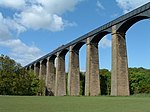
|
Trevor, Wrexham, [51] |
England | 52°58′12″N 3°05′13″W / 52.970°N 3.087°W | 1795–1805[51] | 1303; 2009; i, ii, iv[51] |
The aqueduct was built to carry the Ellesmere Canal over the Dee Valley. Completed during the Industrial Revolution and designed by Scottish Engineer Thomas Telford, the aqueduct made innovative use of cast and wrought iron, influencing civil engineering across the world.[51][52] |
| Royal Botanic Gardens, Kew | 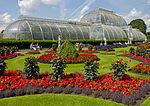
|
Kew, Greater London, [53] |
England | 51°28′26″N 0°17′42″W / 51.474°N 0.295°W | 18th–20th centuries[53] | 1084; 2003; ii, iii, iv[53] |
Created in 1759, the influential Kew Gardens were designed by Charles Bridgeman, William Kent, Capability Brown, and William Chambers. The gardens were used to study botany and ecology and furthered the understanding of the subjects.[53] |
| St Kilda | 
|
St Kilda, [54] |
Scotland | 57°48′58″N 8°34′59″W / 57.816°N 8.583°W | n/a | 387; 1987 (modified in 2005 and 2008); iii, v, vii, ix, x[54] |
Although inhabited for over 2,000 years, the isolated archipelago of St Kilda has had no permanent residents since 1930. The islands' human heritage includes various unique architectural features from the historic and prehistoric periods. St Kilda is also a breeding ground for many important seabird species including the world's largest colony of gannets and up to 136,000 pairs of puffins.[54][55] |
| Saltaire | 
|
Saltaire, Shipley, West Yorkshire, [56] |
England | 53°50′13″N 1°47′24″W / 53.837°N 1.790°W | 1853[56] | 1028; 2001; ii, iv[56] |
Saltaire was founded by mill-owner Titus Salt as a model village for his workers. The site, which includes the Salts Mill, featured public buildings for the inhabitants and was an example of 19th-century paternalism.[56] |
| The Slate Landscape of Northwest Wales | 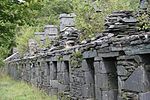
|
Gwynedd, |
Wales | 18th–20th centuries[57] | 1633; 2021; ii, v[57] |
The six key areas, all located in Gwynedd, are: Penrhyn Slate Quarry and Bethesda, and the Ogwen Valley to Port Penrhyn; Dinorwig Slate Quarry Mountain Landscape; Nantlle Valley Slate Quarry Landscape; Gorseddau and Prince of Wales Slate Quarries, Railways and Mill; Ffestiniog: its Slate Mines and Quarries, 'city of slates' and Railway to Porthmadog; Bryneglwys Slate Quarry, Abergynolwyn Village and the Talyllyn Railway.[58] | |
| Stonehenge, Avebury and Associated Sites | 
|
Wiltshire, [59] |
England | 51°10′44″N 1°49′31″W / 51.1788°N 1.8252°W | 4th–2nd millennia BC[59] | 373; 1986 (modified in 2008); i, ii, iii[59] |
The Neolithic sites of Avebury and Stonehenge are two of the largest and most famous megalithic monuments in the world. They relate to man's interaction with his environment. The purpose of the henges has been a source of speculation, with suggestions ranging from ceremonial to interpreting the cosmos. "Associated sites" includes Silbury Hill, Beckhampton Avenue, and West Kennet Avenue.[59] |
| Studley Royal Park including the Ruins of Fountains Abbey | 
|
North Yorkshire, [60] |
England | 54°06′58″N 1°34′23″W / 54.116°N 1.573°W | 1132 (abbey), 19th century (park)[60] |
372; 1986; i, iv[60] |
Before the Dissolution of the Monasteries in the mid-16th century, Fountains Abbey was one of the largest and richest Cistercian abbeys in Britain and is one of only a few that survives from the 12th century. The later garden, which incorporates the abbey, survives to a large extent in its original design and influenced garden design in Europe.[60] |
| Tower of London | 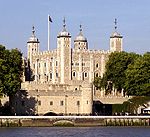
|
Tower Hamlets, Greater London, [61] |
England | 51°30′29″N 0°04′34″W / 51.5080°N 0.0761°W | 11th century[61] | 488; 1988; ii, iv[61] |
Begun by William the Conqueror in 1066 during the Norman conquest of England, the Tower of London is a symbol of power and an example of Norman military architecture that spread across England. Additions by Henry III and Edward I in the 13th century made the castle one of the most influential buildings of its kind in England.[61] |
Site not regarded as part of UK list
[edit]In addition, one world heritage site falling within the Sovereign Base Areas of Akrotiri and Dhekelia is regarded as a site of Cyprus. This is as the 1960 treaty with Cyprus stipulates that "the ancient monuments and antiquity will be administered and maintained by the Republic of Cyprus".[62]
| Site | Image | Location | Criteria | Area ha (acre) |
Year | Description | Refs |
|---|---|---|---|---|---|---|---|
| Paphos (Kourion portion) | 
|
Episkopi Cantonment, Episkopi, Limassol, |
Cultural: (iii)(vi) |
— | 1980 | [63][64] |
Tentative list
[edit]The Tentative List is an inventory of important heritage and natural sites that a country is considering for inscription on the World Heritage List, thereby becoming World Heritage Sites. The Tentative List can be updated at any time, but inclusion on the list is a prerequisite to being considered for inscription within a five- to ten-year period.[65]
The UK's Tentative List was last updated on 25 July 2014, and consisted of 11 sites (3 of which have since been inscribed as World Heritage Sites). The properties remaining on the Tentative List in 2022 are as follows:[66]
| Name | Image | Location | Date | UNESCO data |
|---|---|---|---|---|
| Chatham Dockyard and its Defences | 
|
Kent, 51°39′47″N 0°53′40″E / 51.66306°N 0.89444°E[67] |
17th–19th centuries[67] | 5670; 2012; ii, iv[67] |
| Creswell Crags | 
|
Derbyshire, 53°16′N 1°12′W / 53.26°N 1.20°W[68] |
60–15 thousand years ago[68] | 5671; 2012; iii[68] |
| Darwin's Landscape Laboratory | 
|
Greater London, 51°19′50″N 0°03′04″E / 51.33056°N 0.05111°E[69] |
1842–1882[69] | 5672; 2012; iii, vi[69] |
| Island of St Helena | 
|
16°0′0″N 5°45′0″W / 16.00000°N 5.75000°W[70] |
— | 5675; 2012; x[70] |
| Mousa, Old Scatness and Jarlshof: the Zenith of Iron Age Shetland | 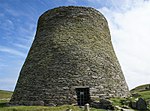
|
Shetland, |
4,000 years ago[71] | 5677; 2012; iii, iv[71] |
| The Twin Monastery of Wearmouth Jarrow | 
|
Tyne and Wear, |
672/3 (Wearmouth) 681 (Jarrow)[72] |
5681; 2012; ii, iii, iv, vi[72] |
| Turks and Caicos Islands | 
|
21°20′N 71°10′W / 21.333°N 71.167°W[73] |
— | 5682; 2012; x[73] |
In April 2023, an updated UK Tentative List was announced by the Department for Culture, Media & Sport. The 5 new sites on the list will further develop their nominations before submitting them to UNESCO for assessment. The 7 sites on the updated list are:[74]
- Birkenhead the People's Park (Cultural site)
- East Atlantic Flyway – England East Coast Wetlands (Natural site)
- The Flow Country (Natural site)
- Gracehill Moravian Church Settlements (Cultural, Transnational site)
- Little Cayman Marine Parks and Protected Areas (Natural site)
- York (Cultural site)
- The Zenith of Iron Age Shetland (Cultural site)
Former UNESCO World Heritage Site
[edit]| Name | Image | Location | Date | UNESCO data | Description |
|---|---|---|---|---|---|
| Liverpool – Maritime Mercantile City†[75][14] | 
|
Liverpool, Merseyside, 53°24′N 2°59′W / 53.40°N 2.99°W[76] |
18th and 19th centuries[76] | 1150; 2004; ii, iii, iv[76] |
In the 18th and 19th centuries, Liverpool was one of the largest ports in the world. Its global connections helped sustain the British Empire, and it was a major port involved in the slave trade until its abolition in 1807, and a departure point for emigrants to North America. The docks were the site of innovations in construction and dock management.[76] The site was listed as endangered in 2012 and removed from the World Heritage List in 2021, as the construction of new buildings in the area had destroyed the "outstanding universal value" of Liverpool's waterfront.[13][14] |
See also
[edit]- List of World Heritage Sites in Europe
- List of World Heritage Sites in Scotland
- Lists of World Heritage Sites
- Tourism in the United Kingdom
Notes
[edit]- ^ A mixed site is one that falls under both natural and cultural criteria.
References
[edit]- Citations
- ^ "The World Heritage Convention". UNESCO. Retrieved 17 September 2010.
- ^ a b c United Kingdom of Great Britain and Northern Ireland: Properties inscribed on the World Heritage List, UNESCO, retrieved 16 August 2009
- ^ "Welsh Slate Landscape UK's newest UNESCO World Heritage Site". GOV.UK. Retrieved 28 July 2021.
- ^ Watch: Bath added as UNESCO World Heritage site with 10 other European towns, 26 July 2021, retrieved 28 July 2021
- ^ UNESCO Constitution, UNESCO, retrieved 17 August 2009
- ^ Funding, Department for Culture, Media and Sport, archived from the original on 18 August 2009, retrieved 17 August 2009
- ^ About us, The United Kingdom National Commission for UNESCO, archived from the original on 28 February 2009, retrieved 17 August 2009
- ^ World Heritage, The United Kingdom National Commission for UNESCO, archived from the original on 8 July 2017, retrieved 29 September 2017
- ^ The Criteria for Selection, UNESCO, retrieved 27 July 2009
- ^ a b World Heritage List, UNESCO, retrieved 27 July 2009
- ^ New publication spotlights St Kilda, Scottish Natural Heritage, 9 December 2004, archived from the original on 12 January 2009, retrieved 16 August 2009
- ^ Dual World Heritage Status For Unique Scottish Islands, National Trust for Scotland, 14 July 2005, archived from the original on 2 October 2006, retrieved 16 August 2009
- ^ a b "Liverpool – Maritime Mercantile City Threats to the Site (2012)". Retrieved 3 October 2013.
- ^ a b c Halliday, Josh (21 July 2021). "Unesco strips Liverpool of its world heritage status". Guardian. Guardian. Retrieved 21 July 2021.
- ^ "Frontiers of the Roman Empire". unesco.org.
- ^ a b c d Blenheim Palace, UNESCO, retrieved 27 July 2009
- ^ a b c d Canterbury Cathedral, St Augustine's Abbey, and St Martin's Church, UNESCO, retrieved 15 August 2009
- ^ Historic England, "Church of St Martin (1242166)", National Heritage List for England, retrieved 16 August 2009
- ^ Historic England, "St Augustine's Abbey (464466)", Research records (formerly PastScape), retrieved 16 August 2009
- ^ a b c d Castles and Town Walls of King Edward in Gwynedd, UNESCO, retrieved 12 August 2009
- ^ Liddiard (2005), p. 9.
- ^ a b c d City of Bath, UNESCO, retrieved 29 July 2009
- ^ a b c d Cornwall and West Devon Mining Landscape, UNESCO, retrieved 12 August 2009
- ^ a b c Derwent Valley Mills, UNESCO, retrieved 27 July 2009
- ^ Derwent Valley Mills Partnership (2000), pp. 30–31, 96.
- ^ a b c Dorset and East Devon Coast, UNESCO, retrieved 29 July 2009
- ^ a b c d Durham Castle and Cathedral, UNESCO, retrieved 27 July 2009
- ^ a b c The English Lake District, UNESCO, retrieved 10 July 2017
- ^ a b The Flow Country, UNESCO, retrieved 30 July 2024
- ^ a b Forth Bridge, UNESCO, retrieved 5 July 2015
- ^ a b c d Frontiers of the Roman Empire, UNESCO, retrieved 28 July 2009
- ^ UNESCO World Heritage Centre. "Frontiers of the Roman Empire". Retrieved 1 January 2015.
- ^ a b c d Giant's Causeway and Causeway Coast, UNESCO, retrieved 28 July 2009
- ^ a b c Gorham's Cave Complex, UNESCO, retrieved 15 July 2016
- ^ Finlayson C, Pacheco FG, Rodríguez-Vidal J, et al. (October 2006). "Late survival of Neanderthals at the southernmost extreme of Europe" (PDF). Nature. 443 (7113): 850–3. Bibcode:2006Natur.443..850F. doi:10.1038/nature05195. PMID 16971951. S2CID 4411186. Archived from the original (PDF) on 27 August 2008.
- ^ a b c Gough and Inaccessible Island, UNESCO, retrieved 12 August 2009
- ^ a b Great Spas of Europe, UNESCO, retrieved 25 July 2021
- ^ a b c d Heart of Neolithic Orkney, UNESCO, retrieved 28 July 2009
- ^ a b c Henderson Island, UNESCO, retrieved 28 July 2009
- ^ a b c d Historic Town of St George and Related Fortifications, Bermuda, UNESCO, retrieved 2 August 2009
- ^ a b c d Ironbridge Gorge, UNESCO, retrieved 27 July 2009
- ^ a b c Jodrell Bank Observatory, UNESCO, retrieved 7 July 2019
- ^ UNESCO World Heritage Centre. "Jodrell Bank Observatory". UNESCO World Heritage Centre. Retrieved 9 March 2021.
 Text was copied from this source, which is available under a Creative Commons Attribution-ShareAlike 3.0 IGO (CC BY-SA 3.0 IGO) license.
Text was copied from this source, which is available under a Creative Commons Attribution-ShareAlike 3.0 IGO (CC BY-SA 3.0 IGO) license.
- ^ a b c d Maritime Greenwich, UNESCO, retrieved 29 July 2009
- ^ a b c d New Lanark, UNESCO, retrieved 28 July 2009
- ^ a b c d Old and New Towns of Edinburgh, UNESCO, retrieved 12 August 2009
- ^ a b c d Westminster Palace, Westminster Abbey and Saint Margaret's Church, UNESCO, retrieved 15 August 2009
- ^ History, Westminster Abbey, retrieved 15 August 2009
- ^ Thornbury (1878), p. 567.
- ^ a b c d Pontcysyllte Aqueduct and Canal, UNESCO, retrieved 12 August 2009
- ^ Listed Buildings: Pontcysyllte Aqueduct, Trevor, Wrexham County Borough Council, archived from the original on 13 October 2008, retrieved 12 August 2009
- ^ a b c d Royal Botanical Gardens, Kew, UNESCO, retrieved 28 July 2009
- ^ a b c St Kilda, UNESCO, retrieved 12 August 2009
- ^ Benvie (2000).
- ^ a b c d Saltaire, UNESCO, retrieved 28 July 2009
- ^ a b Slate Industry of North Wales, UNESCO, retrieved 17 July 2016
- ^ Wales Slate World Heritage Site Nomination
- ^ a b c d Stonehenge, Avebury and Associated Sites, UNESCO, retrieved 27 July 2009
- ^ a b c d Studley Royal Park including the Ruins of Fountains Abbey, UNESCO, retrieved 29 July 2009
- ^ a b c d Tower of London, UNESCO, retrieved 28 July 2009
- ^ "SBAA website". sbaadministration.org. Archived from the original on 13 September 2012. Retrieved 10 October 2012.
- ^ "Paphos". UNESCO. Retrieved 17 August 2011.
- ^ "QuestUAV Images Make UNESCO World Heritage Sites Perceptible For Visually Impaired People - QuestUAV News". questuav.com. 26 May 2016. Retrieved 1 June 2018.
- ^ Glossary, UNESCO, retrieved 1 January 2010
- ^ Tentative list of United Kingdom of Great Britain and Northern Ireland, UNESCO, 19 January 2006, retrieved 16 July 2016
- ^ a b c Chatham Dockyard and its Defences, UNESCO, retrieved 17 July 2016
- ^ a b c Creswell Crags, UNESCO, retrieved 17 July 2016
- ^ a b c Darwin's Landscape Laboratory, UNESCO, retrieved 17 July 2016
- ^ a b Island of St Helena, UNESCO, retrieved 17 July 2016
- ^ a b Mousa, Old Scatness and Jarlshof: the Zenith of Iron Age Shetland, UNESCO, retrieved 17 July 2016
- ^ a b The Twin Monastery of Wearmouth Jarrow, UNESCO, retrieved 17 July 2016
- ^ a b Turks and Caicos Islands, UNESCO, retrieved 17 July 2016
- ^ "Government response to the UK Tentative List review". GOV.UK. Retrieved 24 July 2023.
- ^ "Liverpool stripped of Unesco World Heritage status". BBC News. 21 July 2021. Retrieved 21 July 2021.
- ^ a b c d Liverpool – Maritime Mercantile City, UNESCO, retrieved 29 July 2009
- Bibliography
- Benvie, Neil (2000), Scotland's Wildlife, London: Aurum Press, ISBN 978-1-85410-978-1
- Derwent Valley Mills Partnership (2000), Nomination of the Derwent Valley Mills for inscription on the World Heritage List, Derwent Valley Mills Partnership
- Keay, J (1994), Collins Encyclopaedia of Scotland, London: Harper Collins, ISBN 0-00-255082-2
- Liddiard, Robert (2005), Castles in Context: Power, Symbolism and Landscape, 1066 to 1500, Macclesfield: Windgather Press Ltd, ISBN 0-9545575-2-2
- Thornbury, Walter (1878), "St Margaret's Westminster", Old and New London, 3, Victoria County History
External links
[edit]- UNESCO site
- Conservation of historic buildings and monuments portal
- List of World Heritage Sites in Britain





